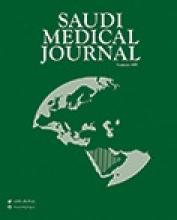To the Editor
With interest, I read the article by Abd Elrahim.1 The author described the morphometry of renal arteries according to the findings of computed tomography angiography. Retrospectively, he reviewed the data of 50 selected kidney donors to study the impact of age and gender on renal vasculature. He reported a significant difference in the length between the right and left renal arteries. Also, significant differences were described in the length and width of renal arteries between males and females. Moreover, aging was found to be associated with a significant reduction in the diameters of renal arteries.
No doubt that the normal renovascular morphometry is significantly important for studying of the renovascular disorders and renal surgical interventions including kidney transplantation. Computed tomography is a reliable and powerful imaging tool for evaluation of renal vessels.2 Dedicated researches to this field are warranted and should be encouraged.
The study is warranted as a trial to reproduce the understanding of the morphometry of renal arteries in the context of complex renovascular disorders. The hypothesis was interesting and the rationale was valuable. This study is expected to provide a significant promotion to the decision-making in the clinical practice of renovascular interventions. However, the article should be professionally criticized to clarify and maximize the benefits. Many aspects could be addressed including the confusing writing mishaps, incomplete description of the participants of the study, and missing discussion of the implications of the reported results at the settings of the donors themselves, kidney transplantation process, and the other medical and surgical renovascular interventions.
Firstly, an inconvenient writing may affect the merit of the work. In the section of Results, the measurement unit (mm) was used by mistake instead of (cm) leading to a wrong reporting of the length of renal arteries. Also, the author reported that “aging was considered one of the most significant risk factor for many RA abnormalities. It was associated with vascular compliance and elevated vascular rigidity” and “aging is established to cause vascular compliance and increased vascular rigidity” in the sections of Introduction and Discussion, respectively. According to what I can understand, these sentences referred to that “vascular compliance” should be a vascular abnormality. However, vascular compliance is a natural physiological vascular characteristic.3,4 So, it should be considered that aging reduces (other than causes) vascular compliance due to the increased vascular rigidity.
Secondly, the author described in the section of Methods that the participants were evaluated specifically for this study. However, he also reported that those participants were kidney donors. It is not clear whether the participants were potential donors who were excluded from kidney donation. Otherwise, they should be real donors and their kidneys had been transplanted into certain kidney recipients. So, many queries may evolve, while the reader is going through this section: Were these participants deceased or living kidney donors? What was the method of selection to be included in the study? Were the data extracted from a kidney transplantation registry? In regards to the age and gender categories, what were the values of their renal functions? Did they reflect any relevant variations? How could an oral consent be taken retrospectively from those donors to participate in this study?
Thirdly, kidney transplantation is a prominent field in which the anatomy of renal arteries is very important. In the literature, studying of the multiplicity of renal arteries has attracted the attention more than studying of their dimensions.5 However, I believe that the effects of age and gender on vascular dimensions including the length and diameter are important and should be investigated also. I hoped that if the reported results in this article could be studied in regards to the donors themselves and their corresponding kidney recipients. Also, the addition of the study to the literature could be augmented, if there was a correlation between the current results of the morphometric variations of renal arteries and the volumetric parameters of their corresponding kidneys.
Rabea A. Gadelkareem
Assiut Urology and Nephrology Hospital Faculty of Medicine Assiut University Assiut, Egypt ORCID ID: https://orcid.org/0000-0003-4403-2859
Reply from the Author
Firstly many thanks to Dr. Rabea A. Gadelkareem for his beneficial comments on my article entitled computed tomography evaluation of renal artery morphometry in adults. The impact of age and gender.1
The first comment is that, an inconvenient writing may affect the merit of the work. In the Results sections, the measurement unit (mm) was used by mistake instead of (cm) leading to a wrong reporting of the length of renal arteries.
Respond: That is right there is a mistake but it is normally to get a wrong things in the writing of article I revised this article more than 20 times but unfortunately still this is a mistake. The readers of this article are specialist in urology, anatomy or generally in the field of medicine so that they must know this measurement in cm.
The second comment is the participants were kidney donors. It is not clear whether the participants were potential donors who were excluded form kidney donation.
Respond: the purpose of selecting the participants a 50 donor is that this group have the most normal measurement of renal arteries.
- Copyright: © Saudi Medical Journal
This is an open-access article distributed under the terms of the Creative Commons Attribution-Noncommercial-Share Alike 3.0 Unported, which permits unrestricted use, distribution, and reproduction in any medium, provided the original work is properly cited.






